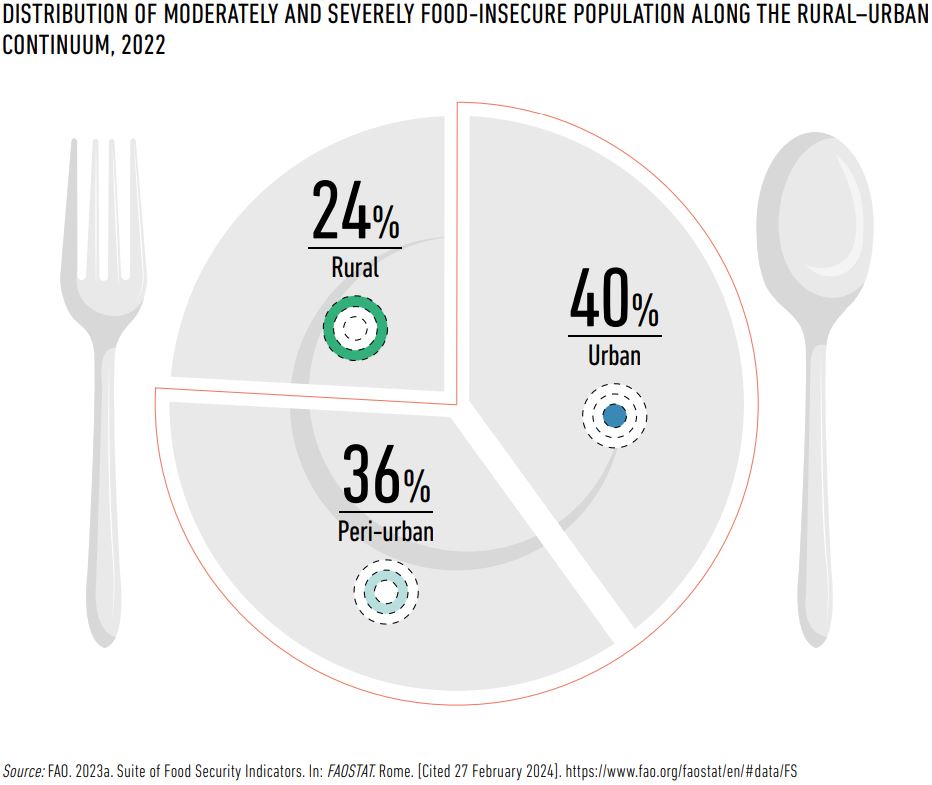The launch of the HLPE-FSN report marks a significant milestone in addressing the challenges and opportunities presented by urban and peri-urban food systems.

Akiko Suwa-Eisenmann, HLPE-FSN Chairperson, Jane Battersby, HLPE-FSN drafting team leader, and Paola Termine, HLPE-FSN Coordinator ad interim, during the launch of the report in Rome, Italy.
©FAO/Alessia Pierdomenico
As urbanization rapidly transforms our global landscape, understanding and improving urban and peri-urban food systems is becoming ever more critical. The latest report from the High Level Panel of Experts on Food Security and Nutrition (HLPE-FSN) of the UN Committee on World Food Security (CFS), titled "Strengthening urban and peri-urban food systems to achieve food security and nutrition, in the context of urbanization and rural transformation," launched on 2 July, delves into these pressing issues with a comprehensive and analytical approach. This report represents a significant milestone in addressing the complexities of food security in our rapidly urbanizing world.
The launch of this report marks a significant milestone in addressing the challenges and opportunities presented by urban and peri-urban food systems. During the event, speakers highlighted the comprehensive, evidence-based analysis that went into the report. This analysis integrates diverse forms of knowledge and underwent extensive e-consultations and external peer reviews, ensuring the importance and reliability of the findings and recommendations presented.
During the launch, the significance of urban and peri-urban areas was emphasized by notable figures such as the FAO Chief Scientist at interim, Beth Crawford, and the Chairperson of the CFS, H.E. Ambassador Nosipho Nausca-Jean Jezile. They stressed the critical role these areas play in achieving the 2030 Agenda for Sustainable Development. This encompasses not only SDG2 on food security but also other essential goals like eradicating poverty, reducing inequalities, and fostering sustainable and resilient cities.
Akiko Suwa-Eisenmann, HLPE-FSN Chairperson, remarked that "cities are where most consumers in the world are located. Cities are also where most of the world food insecure people live in. And as cities rely mostly on food produced elsewhere, they are dependent on the entire supply chain such as peri-urban and rural food production, logistics, transport, processing, wholesale and retail. Also, food environments, which refer to the economic, social and political conditions that shape people’s dietary choices, are very diverse and complex in cities. Therefore, urban and peri-urban areas are a laboratory for food systems transformation."

Jane Battersby, HLPE-FSN drafting team leader, presented the report and showed how the findings challenge the prevailing narrative that food insecurity is predominantly a rural issue: over 3/4 of the world’s food insecure population are in urban and peri-urban regions; in other words, of the 2.2 billion moderately and severely food‑insecure people in the world, 1.7 billion live in urban and peri-urban areas.
Urban and peri-urban areas are also places of considerable challenges, including youth unemployment, inadequate infrastructure, and stark inequalities. As Akiko Suwa-Eisenmann explained, these areas often juxtapose towering skyscrapers with sprawling slums, highlighting the socio-economic divides. Additionally, cities are vulnerable to environmental hazards, epidemics, political instability, and conflicts, making the task of ensuring food security even more complex.
"This report provides a comprehensive overview of food systems in urban and peri-urban areas, their challenges and their strengths. It shows that urban and peri-urban areas have the power to shape the entire food system of their countries, including rural transformation. Cities lead the way in terms of new foods and nutrition transition. Cities are centers of innovation in food policy. You will find in the report many examples of local initiatives in different countries", she added.

The report offers guiding principles and actionable recommendations tailored to various urbanization contexts globally. It advocates for reorienting food systems toward better nutrition, environmental sustainability, and enhanced agency.
"The policy recommendations outlined in the report are both actionable and forward-thinking”, H.E. Ambassador Nosipho Nausca-Jean Jezile emphasized. “By examining the latest available data and highlighting regional and spatial differences, this report reinforces our commitment to tackling these challenges," she continued.
In its conclusion, the report calls on the CFS and its readers to apply the framework and recommendations in their local contexts. It highlights the crucial role of local actors, such as governments, entrepreneurs, and citizens, who are often overlooked but essential in complementing the actions of national governments. Coordination across all levels of governance is emphasized as key to achieving food security for all.
Akiko Suwa-Eisenmann stated: "Local actors are often neglected but they are key and complement the action of national governments. Coordination across all actors at every level of governance is a must. Please read this report and share it widely: let us work together to achieve food security for all."
The launch of this HLPE-FSN report is a call to action for stakeholders at all levels to recognize and harness the potential of urban and peri-urban areas in transforming food systems. By working together and implementing the report's recommendations, we can move closer to achieving global food security and nutrition goals. The insights presented in this report support the achievement of Sustainable Development Goals and emphasize the need for multi-level governance and concerted efforts to address structural inequalities.
"I urge all policymakers, researchers, and stakeholders to engage with the findings and recommendations of this report. We must consider these strategies to create a food-secure future for urban and peri-urban communities and food systems in general, which are greatly influenced and shaped by cities all over the world. The challenges we face are complex, but with targeted policies and collaborative efforts, we can make significant strides toward achieving our goals," urged Nausca-Jean Jezile.
The report will be presented at CFS’s 52nd plenary session in October 2024 and provide recommendations to the CFS workstream to develop Policy Recommendations on “Strengthening urban and peri-urban food systems to achieve food security and nutrition in the context of urbanization and rural transformation”.
The comprehensive analysis and actionable recommendations provided by this report are invaluable tools as we strive to create inclusive, equitable, and resilient food systems worldwide.
Read the report and the executive summary
Check out the presentation delivered by Jane Battersby